
International Research Journal of Engineering and Technology (IRJET) e-ISSN:2395-0056
Volume: 11 Issue: 11 | Nov 2024 www.irjet.net p-ISSN:2395-0072


International Research Journal of Engineering and Technology (IRJET) e-ISSN:2395-0056
Volume: 11 Issue: 11 | Nov 2024 www.irjet.net p-ISSN:2395-0072
1Sanket Koli, 2Pratik Nagtilak, 3Shridhar Marda,4Mohammed
Sahbi Inamdar
1,2,3,4UGStudents,DepartmentofComputerScienceandEngineering, SVERI’sCollegeofEngineeringPandharpur, MaharashtraIndia
5S. M. Shinde
5Assistant Professor, Department of Computer Science and Engineering, SVERI’s College of Engineering Pandharpur, Maharashtra India*** -
ABSTRACT
ChainMedIQ is an innovative web-based application that merges machine learning (ML) with blockchain technology to revolutionise diagnostics in healthcare. Focused on predicting heart disease, the ML model is trained on extensive patient records, providing accurate and reliable predictions. Blockchain technology ensures that patient data is stored securely, transparently,andimmutably,allowingpatientstoretaincontrolovertheirhealthinformation.Bydecentralisingdatastorage, ChainMedIQ eliminates single points of failure, enhancing the reliability and availability of diagnostic services. The platform fosters trust between patients and healthcare providers by ensuring data integrity and security. ChainMedIQ not only aids cliniciansinmakingdata-drivendecisionsbutalsoempowerspatientswithsecure,decentraliseddatamanagement,leadingto improvedpatientoutcomesandamoreresilienthealthcaresystem.
Keywords:
Machine Learning (ML), Blockchain Technology, Heart Disease Prediction, Healthcare Diagnostics, Data Security, DecentralisedDataManagement,PatientEmpowermentTransparency, PredictiveAnalyticsScalability.
ChainMedIQ is an innovative platform that merges the strengths of machine learning (ML) and blockchain technology to advance healthcare diagnostics, with a particularfocusonheartdisease.Asheartdiseaseremains a leading cause of death worldwide, accurate and timely diagnosis is crucial. ChainMedIQ addresses this need by employing a sophisticated ML model trained on a vast datasetofpatientrecordstopredictthelikelihoodofheart disease with high accuracy. Blockchain technology is integral to ChainMedIQ’s approach, ensuring that patient data is stored in a secure, decentralised, and immutable manner.Thisnotonlyprotectssensitivehealthinformation from unauthorized access but also gives patients control over their data, fostering a more transparent and trustbased relationship between patients and healthcare providers. The decentralized nature of blockchain also eliminates the risk of single points of failure, ensuring the continuous availability and reliability of diagnostic
services[4] ChainMedIQ represents a significant step forward in healthcare, offering a powerful tool for clinicians to make data-driven decisions while empowering patients with secure, transparent data management. By combining ML’s predictive capabilities with blockchain’s security and transparency, ChainMedIQ aims to improve patient outcomes and contribute to a moreresilientandtrustworthyhealthcaresystem.
2.1ExistingmodelThefirstliteraturesource,Rajkomar,A., Dean, J., and Kohane, I. (2018). “Machine Learning in Medicine,” highlights key aspects of machine learning applications in healthcare. Here’s a breakdown of the existingmodelinkeypoints:
1. Promise of ML in Healthcare: Machine learning has the potential to revolutionize healthcare by analyzing vast datasets to improve diagnosis, treatment planning, and patientoutcomes.[2]

International Research Journal of Engineering and Technology (IRJET) e-ISSN:2395-0056
Volume: 11 Issue: 11 | Nov 2024 www.irjet.net p-ISSN:2395-0072
2. Data Utilization: Existing models focus on processing massive amounts of pa tient data, including medical records, imaging, and genomic data, for more precise decision-making.[3]
3. Predictive Analytics: ML models in healthcare are often used for predictive analytics, helping clinicians forecast patient risks, potential diseases, and treatment responses. [1]
4. Risk Stratification: These models assist in identifying high-riskpatients,particularlchroni
5.Algorithm Types: The study highlights algorithms such asSupportVectorMachines(SVMs),NeuralNetworks,and DecisionTreesascommonlyusedtechniquesinhealthcare MLmodels.[7]
6. Clinical Validation Needs: One of the challenges in existingmodelsistheneedforclinicalvalidationtoensure that predictions translate effectively into real-world medicalpractice.
7. Data Quality: The performance of ML models heavily depends on the quality of the data, requiring clean, standardized,andcomprehensivedatasets.
The healthcare system faces significant challenges, particularly in diagnosing and managing heart disease. Traditional diagnostic methods are often inaccurate, leading to delayed interventions. Centralized patient data storage raises concerns about privacy, security, and inefficiency, while patients lack control over their medical records, limiting transparency and trust. Interoperability issues between healthcare systems hinder effective collaboration. Furthermore, the limited adoption of advanced technologies like Machine Learning (ML) and Blockchainrestricts diagnosticaccuracyand data security. Delays in accessing real-time data and regulatory hurdles, includingethicalbiasesand compliancewithprivacylaws, exacerbatetheseproblems.
1.Todevelopamachinelearning-baseddiagnosticsystem.
2.Tointegrateblockchaintechnology.
3.Tocreateasynergisticframework.
4.Todesignauser-friendlymobileapplication.
5.Toprovidereal-timeaccesstomedicalservices.
6.Toensuredatainteroperabilityandsecurity.
7. To optimize the performance of machine learning models.
8.Toexplorethepotentialofpersonalizedmedicine.
1.SupervisedLearningAlgorithms(forDiseasePrediction):
RandomForest:Usedforclassificationofpatientsbasedon their medical history and test results. It builds multiple decisiontreesandoutputsthemostaccuratepredictionfor heartdisease.
Support Vector Machine (SVM): Utilized to create hyperplanesthatdifferentiatebetweenhealthyandat-risk patientsbasedoninputdatafeatures.
Neural Networks (NN): A deep learning approach that processes complex medical data, identifying patterns and makingdiagnosticpredictions.Thenetworkistrainedwith labeled data to ensure high accuracy in heart disease detection.
2.Blockchain(forSecurityandTransparency):
Distributed Ledger Technology (DLT): Blockchain is used to maintain a de centralized ledger of patient records, ensuring that no single party controls the data. All transactions(dataaccess,modifications,etc.)arerecorded andcannotbealtered.
Smart Contracts: Automated contracts are coded to enforcethesecuresharingofpatientdatabetweendoctors and healthcare providers. For example, a smart contract automatically allows a doctor to access patient data once consentisprovidedbythepatient.
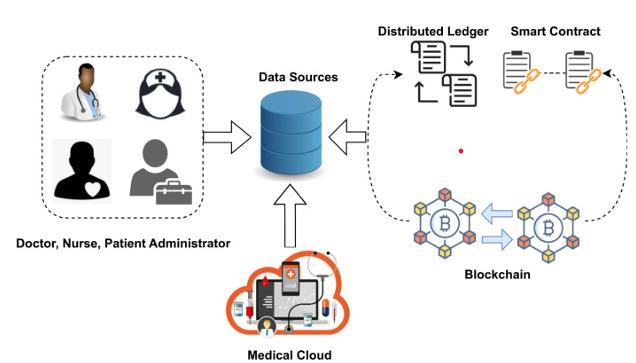

International Research Journal of Engineering and Technology (IRJET) e-ISSN:2395-0056
Volume: 11 Issue: 11 | Nov 2024 www.irjet.net p-ISSN:2395-0072
The development of the ChainMedIQ project follows a structured approach that con sists of multiple phases to ensure the successful design, development, and deploy ment of the system. The project planning involved the followingkeysteps:
1. Requirement Gathering and Analysis: This phase involved a detailed analysis of the healthcare domain to understand the need for a predictive diagnostic system. Meetings with stakeholders, including doc tors,healthcare administrators, and patients, were held to gather comprehensive data on the current challenges in heart diseasediagnosis and data security.Basedontheanalysis, systemrequirementsweredefined.[2][5]
2. Feasibility Study: A technical and economic feasibility study was conducted to evaluate the practicality of using Machine Learning (ML) and Blockchain technologies in healthcare diagnostics. This study ensured that the solution would be viable, scalable, and cost effective for bothhospitalsandindividualusers.[7]
3. System Design: In this phase, both high-level and detailed system architecture designs were created. The designfocusedontheintegrationofMLmodelsfordisease prediction and blockchain for secure data management[3].Various modules, such as the user interface, blockchain, and cloud storage, were designed to interactefficientlywithinthesystem.
4. Prototype Development: A basic prototype was developed to test the core functionalities of the system. This included testing the blockchain’s ability to securely store and manage medical records and ML’s ability to predictheartdiseasebasedonhistoricaldata[4].
5. ML Model Training and Testing: In this phase, machine learning models were trained using large datasets related to heart disease. The models were fine-tuned to improve diagnostic accuracy. Multiple algorithms were tested to identify the most accurate one for predicting heart conditions.
6.Blockchain Integration: The blockchain infrastructure was integrated with the cloud storage and the ML di agnostic system. This phase involved developing smart contracts for automating data access, patient consent management, and securing medical transactions in a decetralizedmanner[6].
7.SystemImplementation:Aftersuccessfulintegration,the full system was implemented, including the user interface
for doctors, patients, and administrators. The system was deployedinacontrolledenvironmentforinitialtestingand evaluation.[3]
8.TestingandValidation:Extensivetestingwasperformed to ensure the system met the required standards for accuracy, security, and usability. Multiple test cases were developedtovalidateboththediagnosticperformanceand theblockchainsecuritymechanisms.
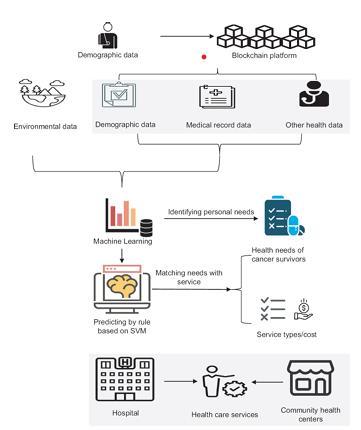
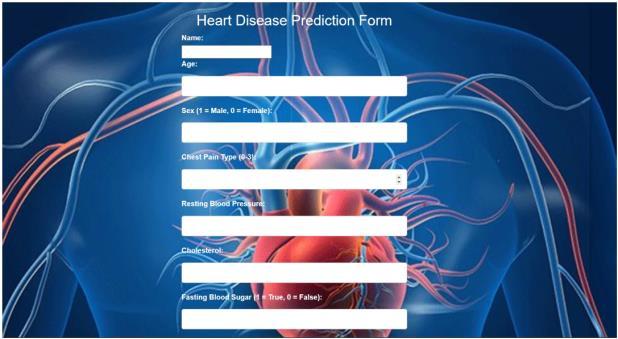

International Research Journal of Engineering and Technology (IRJET) e-ISSN:2395-0056
Volume: 11 Issue: 11 | Nov 2024 www.irjet.net p-ISSN:2395-0072
1.age-ageinyears
2.sex-(1=male;0=female)
3.cp-chestpaintype
4. trestbps-resting blood pressure (in mm Hg on admissiontothehospital)
5.chol-serumcholestoralinmg/dl
6. fbs- (fasting blood sugar ¿ 120 mg/dl) (1 = true; 0 = false)
7.restecg-restingelectrocardiographicresults
8.thalach-maximumheartrateachieved
9.exang-exerciseinducedangina(1=yes;0=no)
10.oldpeak- ST depression inducedby exercise relative to rest looks at stress of heart during excercise unhealthy heartwillstressmore
11.slope-theslopeofthepeakexerciseSTsegment
12. ca- number of major vessels (0-3) colored by flourosopy colored vessel means the doctor can see the blood passing through the more blood movement the better(noclots)
13.thal-thaliumstressresult

Fig4:Output
It predicts about the presence or absense of heart disease and also gives the connected link of blockchain where all thedataofpatientisstoredandwhichisimmutable.
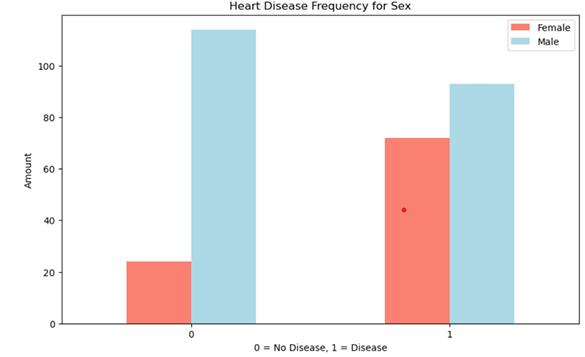
Fig5:NumberofMalesandFemales
The above graph indicates the frequency of the males and femaleshavingdiseaseandnothavingdiseaserespectively
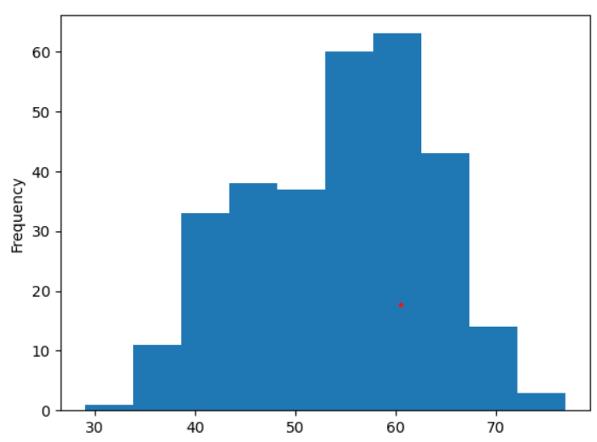
Fig6:Histogramoffrequency
The histogram depicts the frequency distribution of patient ages in the dataset. The majority of patients fall within the age range of 50 to 60 years, indicating that middle-aged and older individuals are more common in this heart disease dataset. There is a gradual increase in frequency from age 40, peaking around the 55-60 age group,andthentaperingoffafterage65.Thisdistribution helps in identifying the target age group most affected by heart conditions, which can assist in focusing diagnostic andpreventiveefforts.

International Research Journal of Engineering and Technology (IRJET) e-ISSN:2395-0056
Volume: 11 Issue: 11 | Nov 2024 www.irjet.net p-ISSN:2395-0072
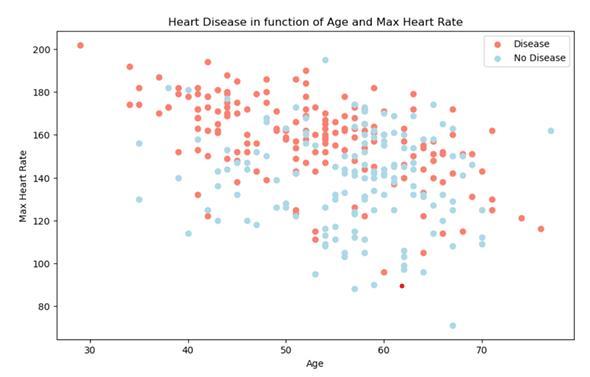
The scatter plot illustrates the relationship between age and maximum heart rate in individuals with and without heart disease. Red dots represent patients diagnosed with heart disease, while blue dots indicate those without. The plotshowsthatpeoplewithheartdiseasegenerallyhavea lower maximum heart rate across different age groups, compared to those without heart disease. The trend suggests that as age increases, the maximum heart rate tendstodecrease,withheartdiseasepatientshavingmore restricted heart rates. This visualization helps in understandinghowheartratemetricscorrelatewithheart diseasediagnosis.
The bar chart represents the accuracy of three machine learning algorithms used in the project: K-Nearest Neighbors (KNN), Logistic Regression, and Random For est. Among the models, Logistic Regression shows the highest accuracy, followed by Random Forest, while KNN has the lowest. This comparison highlights the su perior performanceofLogisticRegressionforthedatasetusedin this study, making it the most reliable model for disease prediction. The difference in accuracy show cases the effectiveness of different algorithms in handling medical dataandmakingdiagnosticpredictions.
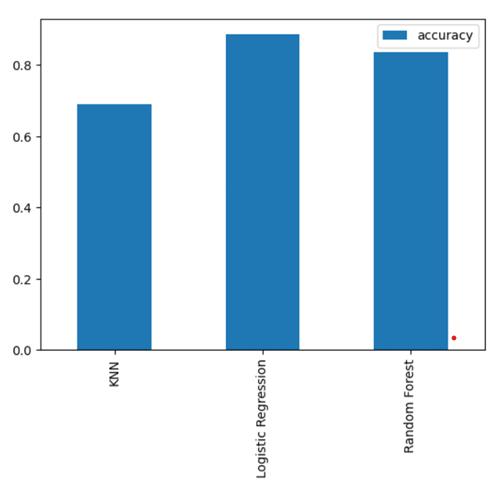
ChainMedIQ represents a significant advancement in the realmofhealthcarediagnosticsbycombiningthestrengths of machine learning (ML) and blockchain technology. By leveragingML,theapplicationaimstodeliveraccurateand reliablepredictionsofheartdisease,enhancingclinicians’ ability to make informed decisions and improving patient outcomes. Blockchain technology complements this by providing a secure, decentralized, and transparent framework for managing patient data, ensuring its integrity and confidentiality. The integration of these technologies not only addresses critical challenges in health care, such as data security and diagnostic accuracy but also empowers patients by giving them control over their health information. Chain MedIQ’s approach fosters greater trust and collaboration between patients and healthcareproviders,ultimatelyleadingtoamoreefficient and resilient healthcare system. While the project faces challenges such as integration complexity, regulatory compliance, and scalability, it holds the promise of transformingdiagnosticprocessesandsettingaprecedent forfuturetechnologicalinnovationsinhealthcare.Through continued development and refinement, Chain MedIQ has the potential to significantly improve how heart disease is diagnosed and managed, paving the way for more se cure andaccuratehealthcaresolutions.
1.AdvancedAIforMulti-DiseasePrediction:Expandingthe system to predict a wider range of diseases beyond heart conditions,usingmoreadvancedmachinelearningmodels

International Research Journal of Engineering and Technology (IRJET) e-ISSN:2395-0056
and incorporating more diverse med ical data for comprehensivediagnostics.
2. Integration with IoT Devices: Connecting the system to wearabledevicesandIoTsensorsforreal-timehealthmon itoring, allowing continuous data collection and more accurate,personalizedpredictionsforpatients.
3. Interoperability with Other Healthcare Systems: Enhancing the system to be interoperable with existing healthcare management plat forms, electronic health records (EHR), and telemedicine services to provide seam less data sharing and improved healthcare workflows acrossorganizations.
1.Rajkomar, A., Dean, J., and Kohane , I. (2018). Machine Learning in Medicine. New England Journal of Medicine, 380(14),1347-1358.DOI:10.1056/NEJMra1614398
2.Deo, R. C. (2015). Machine Learning in Medicine. Circulation, 132(20), 1920-1930. DOI:10.1161/CIRCULATIONAHA.115.015694
3.Agbo, C. C., Mahmoudi, M., and Eklund, J. M. (2019). Blockchain Technology for Healthcare: A Comprehensive Review and Directions for Future Research. Applied Sciences,9(13),2731.DOI:10.3390/app9132731
4.Mamoshina,P.,Kochetov,I.,andPutin,E.(2018). TheRole of Blockchain Technology in Healthcare: A Systematic Review. Journal of Biomedical Informatics, 87, 69-79. DOI: 10.1016/j.jbi.2018.09.014
5.Xia, Q., Wu, Y., and Zhang, L. (2017). Blockchain-Based Data Management for Secure and Reliable Healthcare Services. IEEE Access, 5, 13715-13724. DOI: 10.1109/ACCESS.2017.2723798
6.Gaur, P., and Kaur, N. (2019). Blockchain and Machine Learning: A Synergistic Approach for Healthcare Services. Procedia Computer Science, 152, 45-52. DOI: 10.1016/j.procs.2019.05.001
7.Dey, N., Ashour, A. S., and Tiwari, P. (2016). Machine LearningApproachesforHeartDiseasePrediction. Springer. ISBN:978-3-319-33119-8
8.Coudray,N.,Ocampo,P.S.,andSakellaropoulos,T.(2018). ClassificationandPredictionofHeartDiseaseUsingMachine Learning Techniques. Journal of Healthcare Engineering, 2018.DOI:10.1155/2018/5706573
Volume: 11 Issue: 11 | Nov 2024 www.irjet.net p-ISSN:2395-0072 © 2024, IRJET | Impact Factor value: 8.315 | ISO 9001:2008